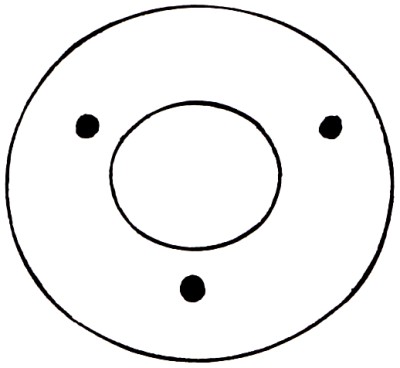Tantra Art as Psychic Matrix
August 16th, 2008
Four images from Mookerjee’s The Tantric Way (see also these yantras).
“Tantra is a creative mystery which impels us to transmute our actions more and more into inner awareness: not by ceasing to act but by transforming our acts into creative evolution. Tantra provides a synthesis between spirit and matter to enable man to achieve his fullest spiritual and material potential. Renunciation, detachment and asceticism — by which one may free oneself from the bondage of existence and thereby recall one’s original identity with the source of the universe — are not the way of tantra. Indeed, tantra is the opposite: not a withdrawal from life, but the fullest possible acceptance of our desires, feelings, and situations as human beings.
“Tantra has healed the dichotomy that exists between the physical world and its inner reality, for the spiritual, to a tantrika, is not in conflict with the organic but rather its fulfillment. His aim is not the discovery of the unknown but the realization of the known, for ‘What is here, is everywhere. What is not here, is nowhere’ (Visvasara Tantra); the result is an experience which is even more real than the experience of the objective world” (p9).

Gunas: sattva, rajas, tamas (p95).
Tantra art “is specially intended to convey a knowledge evoking a higher level of perception, and taps dormant sources of our awareness. This form of expression is not pursued like detached speculation to achieve aesthetic delight, but has a deeper meaning. Apart from aesthetic value, its real significance lies in its content, the meaning it conveys, the philosophy of life it unravels, the world-view it represents. In this sense tantra art is visual metaphysics” (p41).

Shyama (Kali) Yantra. Rajasthan, 18th century (p35).
Yantra “represents an energy pattern whose force increases in proportion to the abstraction and precision of the diagram. Through these power-diagrams creation and control of ideas are said to be possible” (p34).

The Principle of Fire. Rajasthan, 18th century (p189).
“Tantric images have a meditative resilience expressed mostly in abstract signs and symbols. Vision and contemplation serve as a basis for the creation of free abstract structures surpassing schematic intention. A geometrical configuration such as a triangle representing Prakriti or female energy, for example, is neither a reproduced image nor a confused blur of distortion but a primal root-form representing the governing principle of life in abstract imagery as a sign” (p44).

Salagram, a cosmic spheroid (p13).
December 26th, 2008 at 6:08 pm
Greg…
Thank you kindly for this post. As I read through it I see that you are referencing pages in a book, yet I am not clear what book it is. I would love to know.
I am a practitioner of tantra, an explorer and first and foremost an experimenter… Tantra is such a powerful and mysterious path. I love the Osho quote when he says that one’s level of happiness is directly related to one’s level of embrace of mystery. This has definitely been my experience. Tantra is not clear cut, and experienced in so many different levels. It truly is a journey of continual discovery. Diving deeply into our desires, feelings, and situations as human beings is not for the faint of heart. It truly takes great courage to be vulnerable and open enough to be able to take this path beyond…
I am not very learned on the use of yantra, but find this post really interesting. If you could please share the book you got this information from I would be very grateful.
Blessings to you and yours,
Rafa
OmBliss Tantra Kriya Yoga Workshops and Retreats
Visit us at http://www.OmBliss.com
December 26th, 2008 at 10:40 pm
Hi Rafa —
All the words are Mookerjee’s from his book, The Tantric Way. See above for the link.
October 25th, 2009 at 9:15 pm
[…] painting collected in Ajit Mookerjee’s 1971 Tantra Asana (also see previous post). Gunatraya Chakrasana, from a ca. 17th century Nepali manuscript (plate 95). Click for full […]
May 19th, 2013 at 4:47 pm
The Shyama (Kali) Yantra became a meaningful coincidence in my investigations. It coincided with this 1993 crop circle formation —
http://www.greatdreams.com/bythrncc.gif
See the linked article. In the same article, a great coincidence is told about the Sri Yantra on page 57 of the book, and the great pattern that was found grooved into a lake bed in Oregon in 1990.
The Salagram symbol is similar to many crop formations called dumbbells.
November 30th, 2016 at 8:06 pm
It is created for people that desire, through tantric massage, to get
more in effect with their body, open their body to the energy, cure any previous disapproval
of their health and bad experience like concern or disgrace, and
just want to learn to deeply relax, so that the organic
energy will start to circulation and thus bring up any real, lively or emotional conditions
that need to be-released or relieved.
March 8th, 2017 at 7:12 pm
Humana People to People organizations
Humana People to People agencies also mobilize financing for development tasks through transnational organizations, governments,
foundations, UN agencies and private bestower in Europe, North America and Asia.
The partnerships provided genuine, distributed interests in creating development for
the people via at least one of Humana People to People concepts.
Networking among the Humana People to People organizations across continents creates a directly and meaningful partnership between individuals these different regions of the earth.
Humana People to People has created a unique version
In Africa, Humana People to People has evolved a specific version for such susceptible kids called Children’s Town. They are boarding schools with a full-time program, in which kids reside as well as receive classes of academic and helpful life abilities .
The kids have counseling admission to encourage them
to over issues from the past; all with the purpose of granting the
kids lead a sound beneficial life in the future. Schools for kids are
organized about basic education, constructive discipline and state administered examinations.
As a basic element of different schools they often find
goals just like the development of each child to become an important part of
and a participant of the nation’s effort for the better
future.